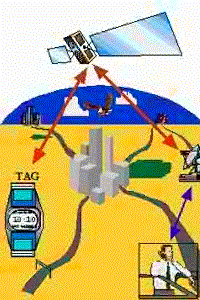



Jack Dunlap's KIDSCAN system, which integrated implantable microchips with satellite tracking technology, never came into being. But other companies are leaping to implement the same basic idea: tracking human beings anywhere on the planet using orbital satellite networks.
 A quick visit to Eagle Eye Technologies' home page (accessible via the weblinks
accompanying this report) shows that global tracking systems are rapidly becoming a reality.
Eagle Eye is developing a wrist-watch sized mobile terminal designed to be compatible with
existing and developing satellite communication systems.
A quick visit to Eagle Eye Technologies' home page (accessible via the weblinks
accompanying this report) shows that global tracking systems are rapidly becoming a reality.
Eagle Eye is developing a wrist-watch sized mobile terminal designed to be compatible with
existing and developing satellite communication systems.
Currently, the broadcasting range of implantable transponders is about three meters or less; some can only be read by a scanner held a few centimeters from the implant. This is hardly adequate for a centralized, all-seeing, all powerful tracking system, especially one with, shall we say, a high rate of non-compliance. Although rapid advancements in nanotechnology will surely solve that problem within a few years, Eagle Eye's Dick Tracy-style wrist-watch terminal serves as a bulkier, but functional, substitute.
A person "tagged" with the wrist-watch can be located on demand via satellite anywhere in the world. Suggested uses for the technology, according to Eagle Eye, include "tracking Alzheimer's patients, children, executives, probationers and parolees, military personnel... and vehicles."
That's a gigantic target market. "Military personnel" could include millions of individuals serving in the armed forces. With one out of every 167 Americans currently incarcerated (the highest rate of imprisonment anywhere on Earth), and millions more on probation, "tagging" the prison population could bring another large segment of society into the "Beast system." Bring children into the mix, and over the course of the next few decades, just about everyone could be tracked from space.
Defense Department's Advanced Research Projects Agency (the same folks who laid the foundation for the Internet) awarded Eagle Eye the contract to build the "Eagle Eye Tag," and the contract is overseen by the U.S. Army Space and Strategic Defense Command at Huntsville, Alabama.
Eagle Eye's tag was designed for compatibility with mobile satellite communication systems such as the Odyssey System and Globalstar. The same geostationary satellites which will soon carry your cellular phone calls from your back yard to the Gobi desert will also allow a prison warden to monitor your location while you pick up trash by the side of the highway.
The Odyssey System is a project being developed jointly by space and defense contractor TRW (which boasted $10 billion in sales in 1995) and Teleglobe, a Canadian telecommunications monopoly. TRW recently held a successful test of a megawatt-class hydrogen/fluoride chemical laser, which will eventually be deployed in orbit as part of the Space-Based Laser missile defense system. According to Teleglobe, the Odyssey System will provide "convenient, effective, consistent communications to subscribers around the globe by the year 2000." It will also carry tracking signals from devices such as the Eagle Eye tag.
Globalstar, a "constellation" of 48 low-earth-orbiting satellites, is being developed by a conglomerate of global telecommunications giants and military-industrial contractors. Globalstar is expected to begin generating a positive cash flow in 1999, the same year the last of the system's satellites are placed in orbit.
Within three years, the backbone for a global transponder tracking system will be a reality. Transmissions from human tracking terminals will flow in a deep digital river of phone calls, modem transfers and faxes. Whether it is used to locate lost kids or track down involuntarily-tagged serfs of the Beast, a global "all seeing eye" will have its gaze firmly fixed on the cloudy blue planet below.

